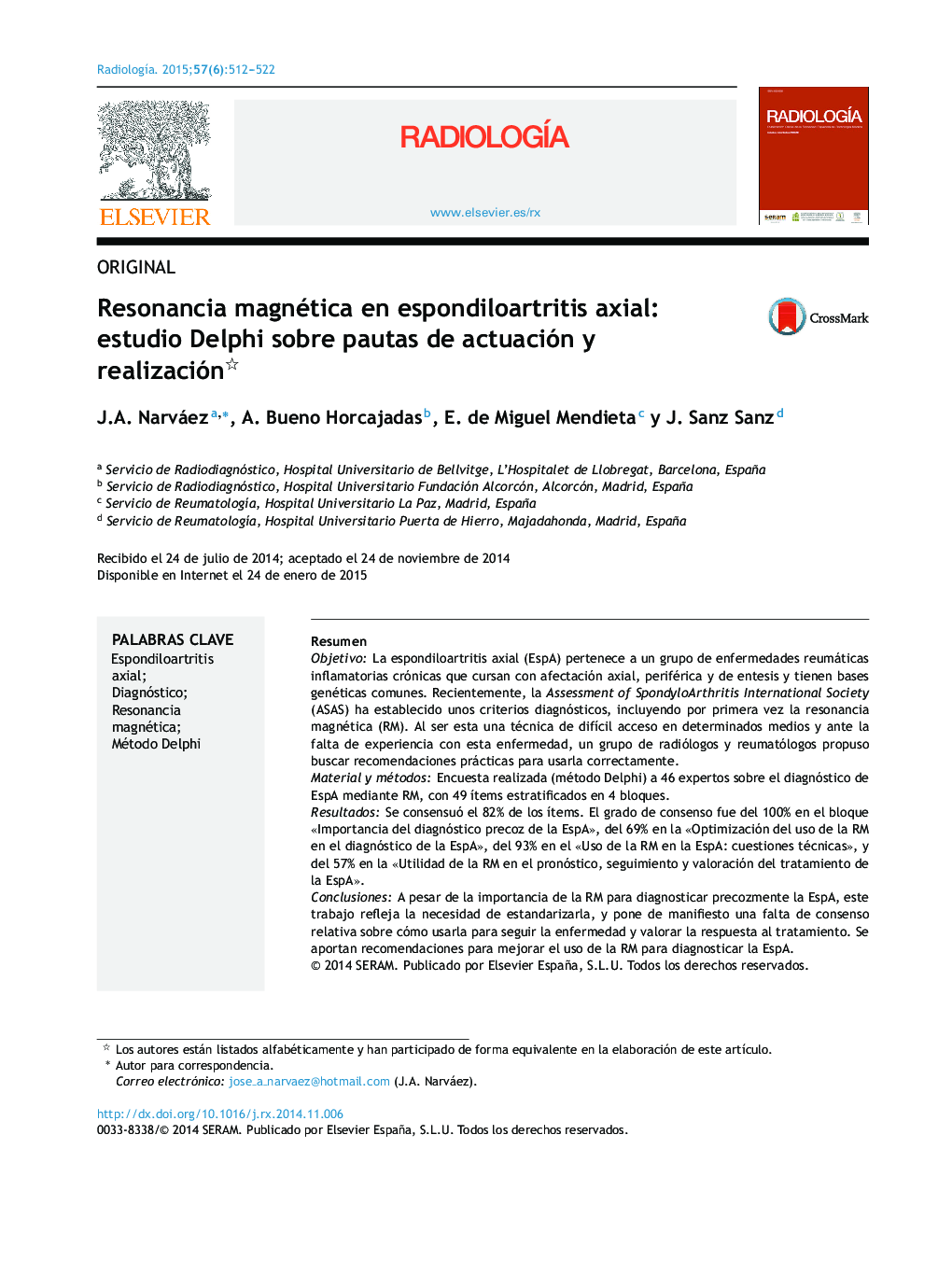| Article ID | Journal | Published Year | Pages | File Type |
|---|---|---|---|---|
| 4245096 | Radiología | 2015 | 11 Pages |
ResumenObjetivoLa espondiloartritis axial (EspA) pertenece a un grupo de enfermedades reumáticas inflamatorias crónicas que cursan con afectación axial, periférica y de entesis y tienen bases genéticas comunes. Recientemente, la Assessment of SpondyloArthritis International Society (ASAS) ha establecido unos criterios diagnósticos, incluyendo por primera vez la resonancia magnética (RM). Al ser esta una técnica de difícil acceso en determinados medios y ante la falta de experiencia con esta enfermedad, un grupo de radiólogos y reumatólogos propuso buscar recomendaciones prácticas para usarla correctamente.Material y métodosEncuesta realizada (método Delphi) a 46 expertos sobre el diagnóstico de EspA mediante RM, con 49 ítems estratificados en 4 bloques.ResultadosSe consensuó el 82% de los ítems. El grado de consenso fue del 100% en el bloque «Importancia del diagnóstico precoz de la EspA», del 69% en la «Optimización del uso de la RM en el diagnóstico de la EspA», del 93% en el «Uso de la RM en la EspA: cuestiones técnicas», y del 57% en la «Utilidad de la RM en el pronóstico, seguimiento y valoración del tratamiento de la EspA».ConclusionesA pesar de la importancia de la RM para diagnosticar precozmente la EspA, este trabajo refleja la necesidad de estandarizarla, y pone de manifiesto una falta de consenso relativa sobre cómo usarla para seguir la enfermedad y valorar la respuesta al tratamiento. Se aportan recomendaciones para mejorar el uso de la RM para diagnosticar la EspA.
ObjectiveThe term axial spondyloarthritis refers to a group of chronic inflammatory rheumatic diseases with a common genetic basis that course with axial and peripheral involvement and enthesitis. Recently, the Assessment of SpondyloArthritis international Society (ASAS) established some diagnostic criteria, including for the first time magnetic resonance imaging (MRI) findings. Given the difficulties of obtaining MRI in some environments and the lack of experience with axial spondyloarthritis, a group of radiologists and rheumatologists sought to establish some practical guidelines to ensure the correct use of MRI in this disease.Material and methodsUsing the Delphi method, we used a questionnaire with 49 items stratified into 4 blocks to survey 46 experts in the MRI diagnosis of axial spondyloarthritis.ResultsThe experts agreed on 82% of the items. The degree of agreement was 100% in the block “Importance of early diagnosis of axial spondyloarthritis”, 69% in the block “Optimization of the use of MRI in the diagnosis of axial spondyloarthritis”, 93% in the block “Use of MRI in axial spondyloarthritis: Technical aspects”, and 57% in the block “Usefulness of MRI in the prognosis, follow-up, and evaluation of the response to treatment in axial spondyloarthritis”.ConclusionsDespite the importance of MRI in the early diagnosis of axial spondyloarthritis, this study shows the need for standardization and points to relative disagreement about how to use MRI in the follow-up of the disease and evaluation of the response to treatment. The results of this study can help improve the use of MRI in axial spondyloarthritis.
